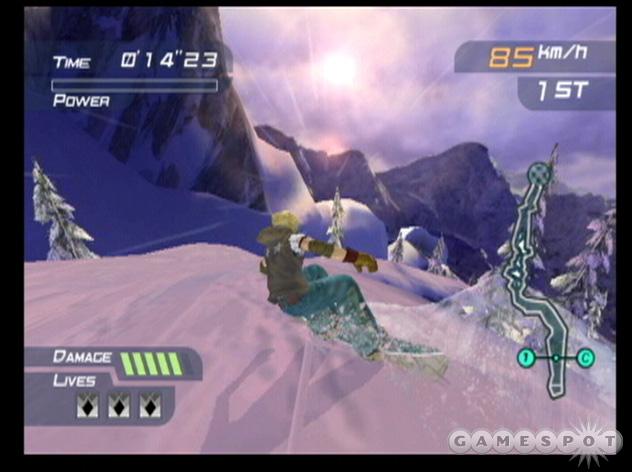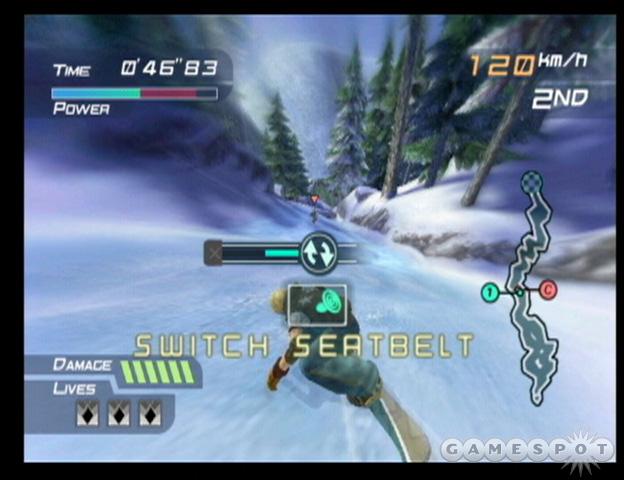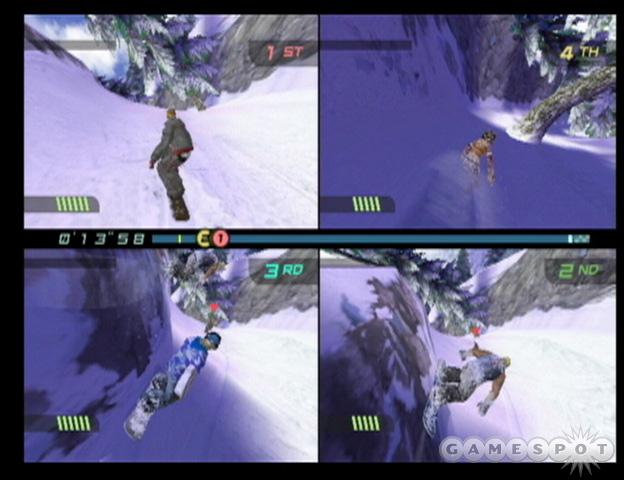Most of Nintendo's GameCube games this year have been new installments in its established franchises. A number of them have also been racing games, and 1080 Avalanche falls into this particular subcategory, alongside the previously released F-Zero GX, Kirby Air Ride, and Mario Kart: Double Dash!! One of the first games unveiled for the GameCube even prior to the system's release, 1080 Avalanche is the sequel to 1998's excellent Nintendo 64 snowboarding game 1080 Snowboarding, but this new game seems unlikely to enjoy its predecessor's popularity. 1080 Avalanche delivers a sometimes thrilling sensation of speed and features a number of nice touches not found in other snowboarding games on the market, but it has very limited lasting value in its single-player mode, and the split-screen multiplayer mode and network play option don't do much to compensate for this shortcoming. The game is fun to play, but there just isn't much to it.

Fans of the original 1080 Snowboarding will notice many similarities between that game and its new sequel. A nicely done animated main menu--styled after a ski lodge--lets you choose from the available game modes, it lets you choose a boarder, and it also lets you choose a board. The game's loading times between its various courses are actually a little lengthy, though during them, you can sample the game's selection of licensed music, which mostly consists of indie rock and electronic beats that nicely fit the theme of the game. A minor issue with the interface is that you need to use the control stick to navigate most of the menus, yet you need to use the D pad to select music. The manual offers profiles of the game's five main characters, each of whom is ranked differently for speed, acceleration, jumping, turning, and balance. These differences, however, are not particularly pronounced during gameplay, nor are the characters' personalities. Not that this stuff really matters, since it's all about the action on the slopes.
This is where the tried-and-true gameplay of 1080 Snowboarding shines through once again. Though there are other snowboarding games currently on the shelves, including EA's excellent SSX 3 and Microsoft's Amped 2, 1080 Avalanche plays quite differently from these and delivers some terrifically fast snowboarding, at times. For some reason, your speed in the game is listed in kilometers per hour and no miles-per-hour option is available, but you won't need a big number to tell you when you're going extremely fast here. Speed lines rush toward the sides of the screen, and the camera begins to shudder and then fisheyes as everything on the edges of your field of vision dramatically stretches out as you move faster and faster. Unfortunately, 1080 Avalanche's frame rate just can't keep up and often noticeably starts to chug. That undermines the game's otherwise fairly impressive looks, but still, when you're hurtling along at blazing speeds, you won't have too much time to care.

Apart from using the L button to tuck, lowering your boarder's profile to increase his or her speed at the expense of maneuverability, and using the control stick to edge the board around turns to otherwise keep yourself on track, 1080 Avalanche also features a trick system. The most interesting aspect of the trick system is actually what happens when you screw up a landing. Though you'll bail if you crash straight into something or if you completely botch a trick, it's more common for your boarder just to lose balance. You'll slow down and eventually fall over when this happens, but by quickly spinning the control stick, you can regain your footing and can carry on. This is a simple but nicely handled mechanic. You'll quickly master it, though, because the penalty for taking a dive is often the difference between winning the race or not. It doesn't take that long to get back on your feet after you fall over, but sometimes you'll stand back up in a place that makes it difficult to get back on the main course and up to speed. So, just avoid getting knocked over, right?
As for the trick system itself, it's pretty simple. You can plant your feet for a jump, and then, while airborne, you can execute the standard assortment of grabs, spins, and flips. It's pretty easy to pull off tricks, as well as to grind on rails. There are some stunt courses in which the goal is to string together as many tricks as possible, for high-scoring combos, but in most modes of play, the benefit of tricking is a boost to your power meter. It takes just a few good tricks, or one long grind, to fill it out, at which point your boarder will start shimmering. This shimmering represents a heightened state that allows him or her to knock over any opposing boarder or to recover quickly from a fall. Tricking during a race tends to unnecessarily put you in danger, so the strategy is to max out the power meter as soon as possible, then stop tricking until your powered-up state goes away (and it only goes away when you knock over an opponent or take a spill yourself).
The focus of most modes of play in 1080 Avalanche is to reach the finish line first and as quickly as possible. The match races are the main single-player mode. Divided up into three difficulty settings (followed by a series of tough bonus missions), which must be played in sequence, these match races can be finished in a couple of hours or so. The object of each course in the series is merely to beat a single rival racer to the finish line. Some fairly apparent rubber-band AI keeps most of the races close--but rather intense--regardless of how well you're racing. Last-second victories and losses are common.

The 15 courses that comprise the match races are varied, exaggerated, and mostly quite interesting. They feature various obstacles, shortcuts, some traffic (in the form of other boarders, skiers, snowmobiles, cars, wildlife, and more), and natural disasters, but they're also mostly quite short--maybe two or three minutes long--and are therefore relatively easy to learn and to master. A few contrivances prevent you from finishing the event race mode even faster than the short amount of time required. You have a limited number of "lives" with which to attempt each difficulty mode. After three tries, you need to start that series of courses over again. A less abstract detail is that your boarder has a health bar; each time you take a spill, you lose some health, and if you run out, you're disqualified. This is a perfectly sensible idea, though, in practice, it's not much to be concerned about--with the possible exception of an annoyingly incessant "danger" chime you'll hear when your health is low.
The game's other modes include time trial, gate challenge, and trick attack. The latter mode, as mentioned, invites you to try to get as high of a score as possible to compete against posted scores. It's here where the trick system obviously has more purpose than in the other modes. "Time trial" is a misnomer for the game's so-called mode, in which you're ostensibly trying to reach the finish line as quickly as possible, but you're also trying to find pieces of a coin in each track. The pieces can be relatively hidden, and only by collecting all the pieces do you earn a coin. So you'll probably end up going slowly rather than quickly through the time trial races. The coins you earn here can be used to unlock additional boards for your riders, which affect their stats. Finally, the gate challenge mode puts you on courses in which you'll need to pass through colored gates, as a test of your control and precision as a racer. This mode can be relatively fun and is actually good practice for the other races.
A split-screen multiplayer mode for up to four players offers only a limited selection of the 15 main courses. And, unfortunately, with four players going at it, the game runs poorly and just isn't much fun. The frame rate holds up much better when you limit the action to two players. Games such as this can inherently be more fun when played with friends, and the power-up system lends itself to some pretty satisfying overtakes--so if you crash into your buddies, you can leave them face first in the powder. On the other hand, the limited variety available here, as well as the game's generally lackluster frame rate performance, keeps this mode from being too attractive. 1080 Avalanche also offers four-player support over a local area network, an impractical feature that's no replacement for online play. The fact that the LAN mode is still limited to four players makes it pretty hard to get excited about.

As mentioned, 1080 looks quite good, though it would have looked significantly better if only its frame rate held up more consistently. The environments and the boarders aren't incredibly detailed, but some cool graphical touches, such as how boarders get caked in snow when they fall over or how they flinch as they barely dodge obstacles, make the game attractive. Some of the environmental effects, especially the avalanches you'll race against in a handful of the courses, also look very good, as does the effect of the wind whipping across your boarder's clothing. Meanwhile, 1080's audio is likewise straightforward and effective.
Though some Nintendo fans have been anticipating the release of 1080 Avalanche for years now, this really is an unassuming racing game that doesn't at all give the impression that it's spent a long time in the works. The core action is entertaining, but the frame rate issues and limited gameplay options prevent 1080 Avalanche from being highly recommendable, though it's worth playing.